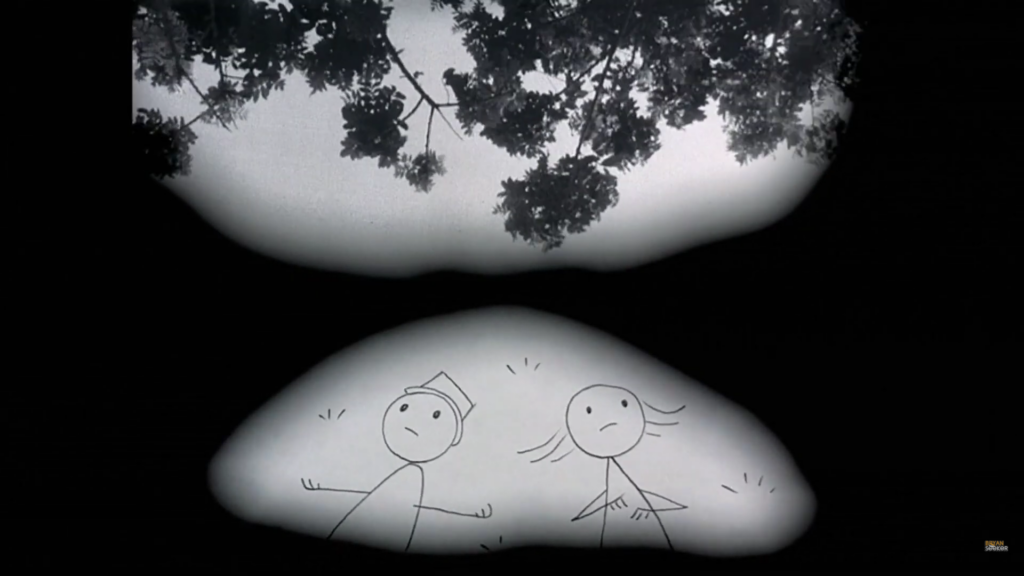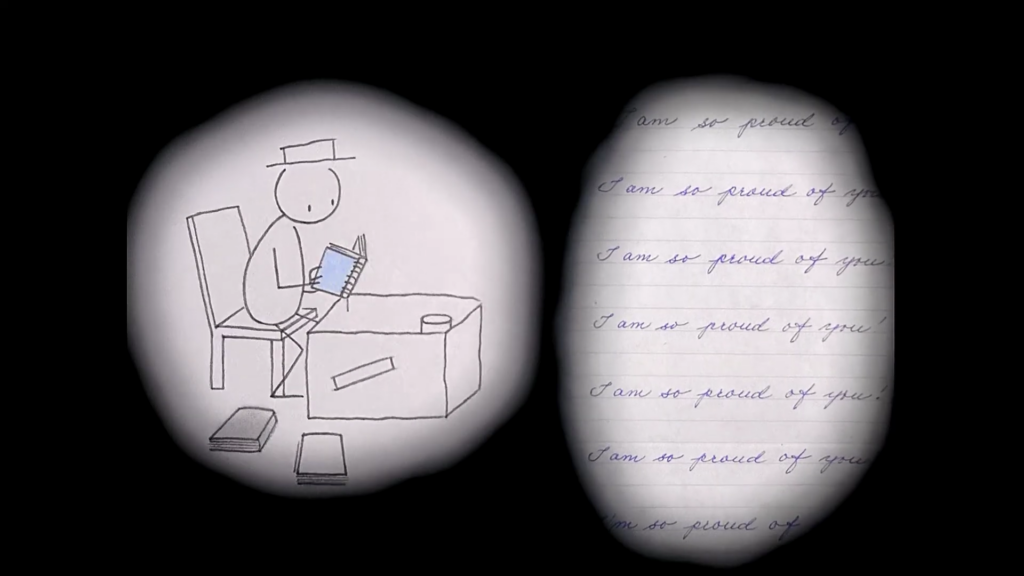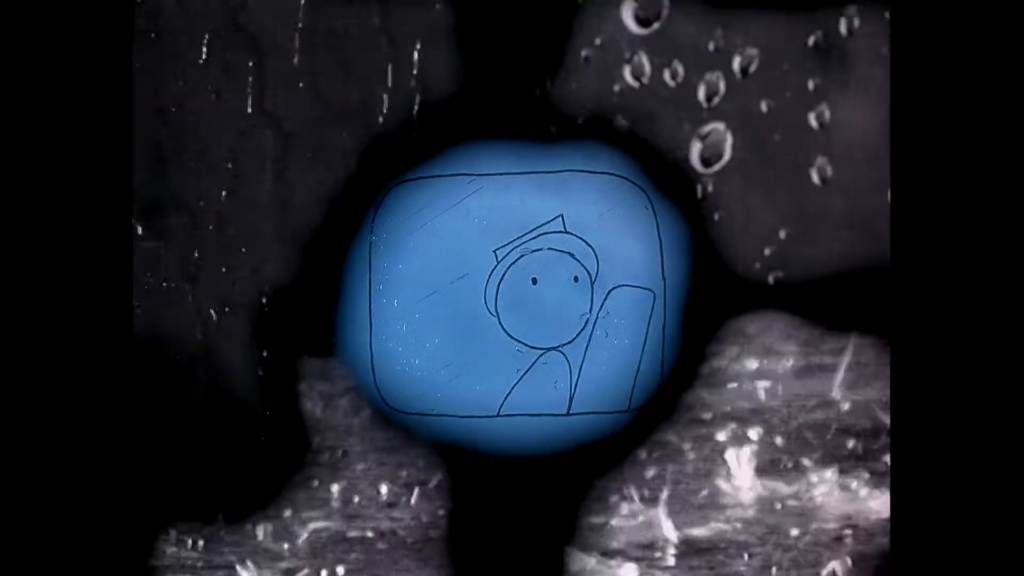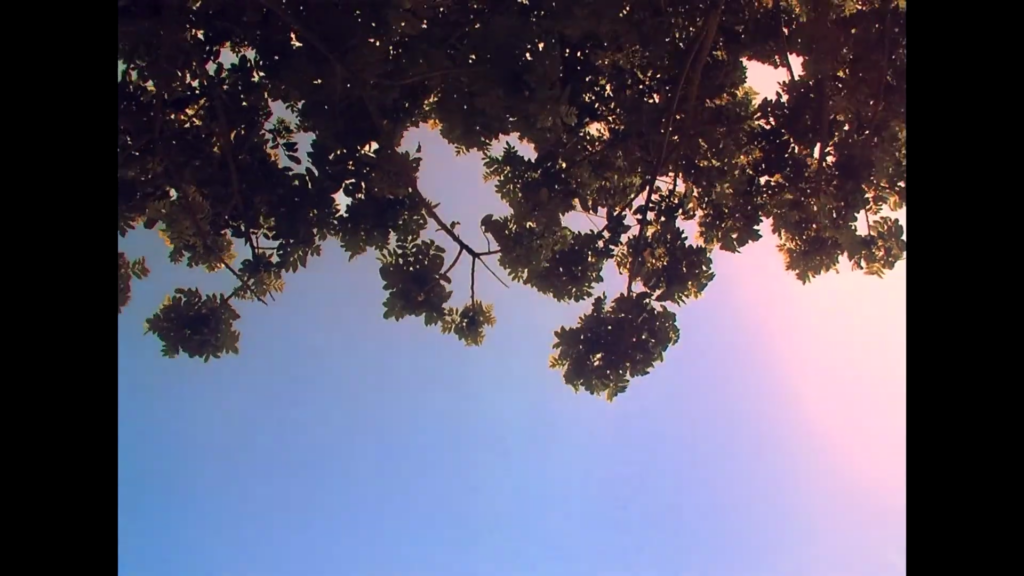| Zach Staads |

It’s Such A Beautiful Day + Me play at the Trylon Cinema Friday, November 8th, through Sunday, November 10th. Visit trylon.org for tickets and more information.
I first saw Don Hertzfeldt’s Everything Will Be OK in my friend’s living room, a cavernous Victorian echo chamber carved from oak and smothered in pink-beige plaster, where we watched on a chunky, green Dell laptop from 2006. Those 17 minutes changed my life.
I remember this moment from a third person view, looking in from the adjoining dining room into a dark living room where a small pool of light enveloped two 15 year old kids, enraptured by what they saw. Now, I could go on about how much of that memory is likely false (a theme Hertzfeldt explores deeply in several of his works) and a romanticization of an otherwise normal moment, but I find it more interesting that I remember it the same way that many of the frames in It’s Such a Beautiful Day are laid out—a vague circle where action is happening surrounded by darkness. Visually, this is a kind of Ma.

Ma is the Japanese concept of negative space, emptiness, or the space in-between objects, people, or actions; it’s a moment of pause, silence, or rest. In the world of painting, it is most classically shown with Hasegawa Tōhaku’s painted folding screens, Pine Trees. In the world of animation, it is most notably used by Hayao Miyazaki.
Miyazaki has spoken several times about what Ma is, and how it allows building tension to grow into a wider dimension as you sit with it.1 His most famous example is from Spirited Away, when the protagonist, Chihiro, rides a train for just under two minutes, sitting among faceless human silhouettes, and watching the world roll by outside. These moments crop up in all his films at one point or another, Kiki lying on a hillside, looking at the sky in Kiki’s Delivery Service, Mahito eating the last grains of rice stuck to his fingers in The Boy and the Heron, or us looking at the beauty of Gina’s secret garden in Porco Rosso. These scenes don’t all build tension necessarily, but they do something else that’s equally important.
In the interview referenced above, Roger Ebert called this phenomenon “gratuitous motion,” where a moment is taken with a character to examine something that gives “the sense of time and place and who they are.” It can be watching water flow, examining the wrinkles of your hands, or watching the clouds move across the sky while the wind shakes the boughs of trees.
We see this quite often in Hertzfeldt’s work. When Bill slowly takes off his hat and rubs his head in the doctor’s office during Everything Will Be OK, Emily’s constant pauses after having to confront her emotions when Emily Prime says, “You missed him” in World of Tomorrow, or the moment (now only viewable on the Blu-ray of It’s Such a Beautiful Day) at the end of his short film Wisdom Teeth when the Man Who Pulls The Stitch looks at his friend getting beaten up, says nothing, turns, and walks away.
These examples show how Hertzfeldt can use these moments of emptiness for both tragedy and comedy, especially considering the first two examples are followed by comic, and tragicomic lines, respectively.2 Hertzfeldt uses Ma to weave tragicomedy like Arachne at the loom,3 showing all the spaces between things in life through deceptively simple visuals and devastating writing. Moments are punctuated by what’s missing; Bill’s grandmother playing grandpa’s bingo card for him in I Am So Proud of You, the lack of any flowers, visitors, or niceties in Bill and Matthew’s room in It’s Such a Beautiful Day, or even the missing memories that haunt so many of Hertzfeldt’s films as characters search to find what they’ve had and lost.
This last point leads me to a different example of Ma in art, Waiting for Godot. A play that is self-defined as a tragicomedy in two acts that is made up of pauses, silences, contemplations, non-sequiturs, comedic moments and lines followed by deeply sad ones, and a whole lot of empty space as the only written out scenery is a dead tree and a large rock. It’s Such a Beautiful Day uses all these techniques as well, jumping between different contemplations, everyday happenings, distorted memories, all while the world as Bill knows it slowly crumbles around him as his brain has continually fails him, and we get to see it through the ever-changing images on screen.

It’s astonishing how both Miyazaki and Hertzfeldt use Ma in different ways to achieve similar goals. Visually they each use the concept in stark contrast to one another; Miyazaki creates worlds that are filled with life through detailed backgrounds and characters, as well as sumptuous colors, while Hertzfeldt uses stick figures and (at least in the case of It’s Such a Beautiful Day) keeps his palette mostly black and white, except when he goes to live action footage which is often rich and incandescent.
Even with those stark differences, these films allow the viewer to let down their guard, be vulnerable, and think critically—not just about what is going on on screen and in the mind of the characters in the film. They also allow us to be vulnerable with our own thoughts and feelings.
I have a real tendency to burn myself out; I jump between events, people, activities, hobbies, projects, and distractions like a pinball in a machine with infinite plays. It’s really hard to get my brain to shut off and just sit down and enjoy a moment; there’s always something going on or something to think about too much. Likewise, many movies bounce between points like that pinball, barely letting up on the gas and at a certain point it can be exhausting.4 Seeing the films of Hertzfeldt and Miyazaki gave me my first taste of sitting with things.
Movies like Spirited Away and Everything Will Be OK planted the idea that I could take a break and take in the world around me a little more. I was allowed to breathe and think, even for a moment, that the contemporary idea of needing to always be ready to move on to the next hustle isn’t all it’s cracked up to be. All of this has colored my life in such a way that, as I type this now, I find myself welling up over the profound effect that these artists have had on my life and art.

Footnotes
1 https://www.rogerebert.com/interviews/hayao-miyazaki-interview
2 “Bill went home and masturbated for seven hours.” & “I do not have the mental or emotional capacity to deal with his loss, but sometimes I sit in a chair, late at night, and quietly feel very bad. When the night is at its most quiet, I can hear death. I am proud of my sadness, because it means I am more alive. I no longer fall in love with rocks.”
3 Not to imply that Hertzfeldt uses it on purpose, but it is undeniably present within his work.
4 I know it’s not a popular opinion, but looking at you The Wild Robot.
Edited by Olga Tchepikova-Treon
